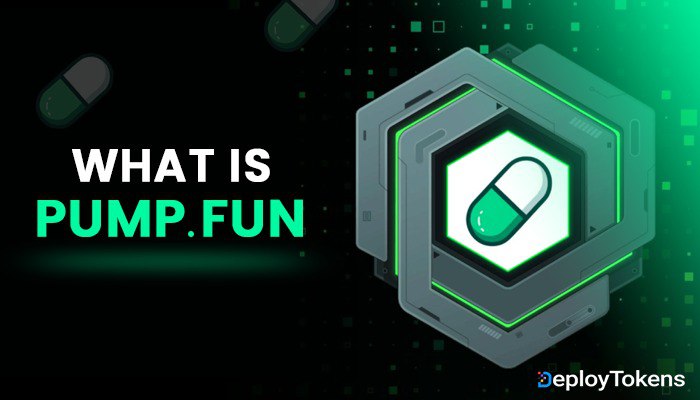The crypto world has seen a surge in meme coins and experimental token launches, and Pump.fun has emerged as one of the most talked-about platforms enabling this trend. But what exactly is Pump.fun, and how does it work? Whether you’re a crypto enthusiast, a developer, or a complete beginner, understanding Pump.fun can help you navigate the growing world of decentralized finance (DeFi) and token creation.
This guide will break down what Pump.fun is, how it functions, and whether it’s the right choice for launching a token. We’ll also address common queries such as its legitimacy, use on different blockchains, and how it compares to other token creation platforms like DeployTokens.
What is Pump.fun?
Pump.fun is a decentralized token launchpad designed to make it easy for users to create and launch their own tokens, primarily on the Solana blockchain. Unlike traditional token creation methods that require coding and smart contract expertise, Pump.fun automates the process, making it accessible even for those with no technical background.
Key Features of Pump.fun:
- Instant Token Creation – Users can create tokens in a few clicks.
- Decentralized Platform – Operates on Solana, offering fast and low-cost transactions.
- Liquidity Pools – Helps creators provide initial liquidity for their tokens.
- Trading & Speculation – Tokens launched can be immediately traded on the market.
While Pump.fun is focused on rapid token launches, platforms like DeployTokens offer a more structured and feature-rich approach for users looking to create sustainable and well-verified tokens.
How Does Pump.fun Work?
Pump.fun is a decentralized token launchpad designed to simplify the process of creating and launching tokens on the Solana blockchain. The platform eliminates the need for coding expertise, allowing users to deploy tokens seamlessly.
Step-by-Step Process of Using Pump.fun
1. Connect a Solana-Compatible Wallet
To begin, users must connect a Solana-based wallet such as Phantom or Solflare. This ensures secure transactions and enables interaction with the platform.
2. Configure Token Parameters
Users define the fundamental aspects of their token, including:
- Token Name & Symbol (e.g., $MOON, $PUMP)
- Total Supply (Total number of tokens available)
- Liquidity Allocation (Determining initial liquidity for market trading)
3. Deploy the Token on Solana
Once the parameters are set, users pay a small network fee in SOL (Solana’s native cryptocurrency), and the token is deployed on the Solana blockchain instantly.
4. Token Trading and Market Activity
After deployment, the token is immediately tradable. Given the speculative nature of many Pump.fun tokens, their market value is often driven by community interest and liquidity.
5. Community Engagement and Growth
Token creators typically engage in marketing efforts, community-building, and potential exchange listings to drive adoption and enhance the token’s visibility.
Key Advantages
- No Technical Expertise Required – A fully automated, user-friendly interface.
- Fast & Cost-Effective Transactions – Solana’s high-speed network ensures efficiency.
- Seamless Trading Integration – Tokens are instantly available for market activity.
Considerations Before Using Pump.fun
While Pump.fun offers a straightforward token creation process, users should be aware of its limitations:
- Limited Smart Contract Customization – The platform offers basic token creation but lacks advanced control features.
- Market Volatility – Many tokens are highly speculative, leading to rapid price fluctuations.
- Security Risks – The ease of token creation also means a higher likelihood of fraudulent projects.
For individuals and businesses seeking a more secure, feature-rich, and scalable token creation process, DeployTokens offers a comprehensive no-code platform with:
- Multi-Chain Support (Ethereum, Binance Smart Chain, Polygon, etc.)
- Automated Smart Contract Verification
- Advanced Token Features (Burn, Mint, Pause, Supply Cap)
- Seamless Wallet Integration
Frequently Asked Question
Is Pump.fun Legit?
Yes, Pump.fun is a legitimate platform, but users should be cautious. The open nature of token creation means there is potential for scams or rug pulls (when token creators abandon a project after selling tokens). It is always advisable to research any project before investing.
Can I Use Pump.fun for Ethereum?
No, Pump.fun primarily operates on Solana. If you want to create Ethereum-based tokens, platforms like DeployTokens offer an easy and secure way to launch ERC-20 tokens.
How Does Pump.fun Compare to DeployTokens?
While Pump.fun specializes in quick and speculative launches, DeployTokens is a feature-rich, secure, and scalable platform that supports multiple blockchains like Ethereum, Binance Smart Chain (BSC), and Polygon. DeployTokens also provides:
- Automated Smart Contract Verification
- Advanced Token Features (Burn, Mint, Pause, Supply Cap)
- No-Code Token Customization
- Seamless Wallet Integration
For users looking for a more robust and verified approach to token creation, DeployTokens is the superior choice.
What are the Risks of Using Pump.fun?
While the platform offers quick token launches, some risks include:
- Lack of Smart Contract Control – Limited customization compared to full development.
- Scam Potential – Easy access means both legitimate and fraudulent tokens can be created.
- High Market Speculation – Many Pump.fun tokens are highly speculative and may not hold long-term value.
Final Thoughts
Pump.fun is an innovative and fast way to create Solana-based tokens, but it comes with its own risks and limitations. If you’re looking for a more secure and customizable option, DeployTokens offers a more structured and feature-packed approach to BEP-20, ERC-20, and multi-chain token creation.
Ready to create your token with more flexibility and security? Explore DeployTokens today and build your next crypto project with ease!
